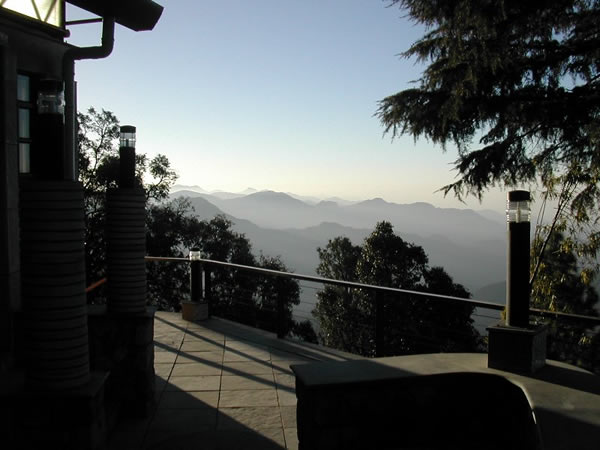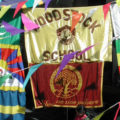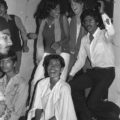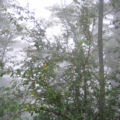The reason (well, excuse, really) for this trip to Mussoorie was to get started on a project for Woodstock School. The school will celebrate its 150th anniversary in 2004, an occasion which calls for a book of some sort. Detailed histories have previously been published, covering the period up to 1983, and a glossy picture book was produced a few years ago. The school has also recently published a collection of essays by alumni (yes, including me), and a book about alumni artists and their work. A group of alumni is working on a history made up of personal stories collected during reunions (see Living on the Edge).
So what could we do that would be new and different? And how can we attract a larger audience than the few thousand alumni, former staff, and families who are somehow personally connected to the school? And why me to head this up?
I puzzled over that last question, but, the further I get into this project, the more it seems that I was destined for it, in spite of a lot of things that I am not.
My connection with Woodstock, unlike others’, does not stretch back generations. The epitome of the old Woodstock family is the Alters: D. Emmet Alter was principal from 1940 to 43. One of his sons, Bob, graduated in 1943 and later returned to the school several times in several capacities, finally as principal from 1968 to 1979; he was instrumental in transforming the school into the international institution that it is today. Bob and Ellen Alter’s three sons (Steve, Joe, and Andy) all attended Woodstock; Steve, a novelist now teaching at MIT, wrote about it in All the Way to Heaven: An American Boyhood in the Himalayas.
Tom Alter, a nephew of Bob, took Indian citizenship and is now a well-known actor and cricket commentator, based in Mumbai. He married a woman who taught at Woodstock at one time. There are other significant Alters; I need to construct a family tree to sort them all out!
I had never heard of Woodstock until Bob and Ellen Alter came on a recruiting visit to Dacca, Bangladesh, around January of 1977. My family had arrived there in October of 1976 (my dad as local head of Save the Children), confidently expecting that I would be able to attend the American school in Dacca for the 8th grade. We were wrong. The school was so small that it had room for only 15 students per grade, and the 8th was already filled. We considered a Bangladeshi school (“English medium”, meaning that all teaching is done in English) but the standards were too different: they were way ahead of me on math and sciences, way behind me on English and writing.
So I began 8th grade work by correspondence, through the Calvert School in Maryland. I initially started it with another girl in the same plight as myself, being taught by her mother. That didn’t go too well, either: I didn’t like the mother.
This had been going on for a few weeks when the Alters appeared. Clearly, my school situation needed fixing, and Woodstock seemed like a good solution. All I remember about my meeting with them was being very concerned that I would be allowed to put up my own posters in my dorm room; I had carried those posters carefully from Pittsburgh to Connecticut to Dacca; they were part of my travelling “home.” The Alters assured me that I could stick up whatever I wanted in my room; I sought detailed advice on what sort of tape to bring.
My 9th grade year at Woodstock would begin in July of 1977, and, having gotten a late start, I had to finish 8th grade in a hurry. I abandoned my study partner and finished 8th grade at double the speed recommended by the Calvert School. I had some help with algebra from an American friend then living with us; otherwise, I did it all on my own (both my dad and stepmother were intensely involved with their own work).
I started 9th grade at Woodstock just in time to save my sanity. The four years I spent there nurtured me, gave me self-confidence, and helped to heal the wounds of my parents’ divorce and other upheavals. Years later, my therapist told me that if I hadn’t gone to Woodstock, I would probably have ended up “gibbering in a corner somewhere.” So my involvement with Woodstock, though it does not (yet) span generations, has been extremely important to me.
In my time, the school was undergoing an important demographic shift, from a student body composed largely of American and Canadian missionaries’ children (mish kids) to a more international mix. My own class represented the “ideal” of 1/3 North Americans (mostly mish kids) – 1/3 Indians – 1/3 Other.
As usual for me, I didn’t fit in with any particular group. In fact, I took pains to set myself apart from some, being vociferously atheist in a Christian school. Nor was I a typical Woodstocker in many other ways. Hiking was popular, given our stunning Himalayan environs, but after a horrible (for me) required 9th grade activity week trek, I never again went on any sort of organized hike.
The school is famous for its music program. I dutifully took piano lessons for three years, but was the despair of my teacher, combining beautiful, long-fingered piano hands with no musicality whatsoever. I gave up on choir after less than a semester because the music was boring.
But Woodstock is so all-embracing a community that I soon found my own niches and ways to contribute. I became a public works artist: I painted murals on the walls of the girls’ dorm; made large batiks to decorate the elementary school; was called upon to create Bottom’s ass’ head and the lion costume for “A Midsummer Night’s Dream.” I was for a time editor of the school paper, and later president of the girls’ dorm. I worked on the yearbook. And, during my senior year, I got interested in the community around us, Mussoorie and Landour.
I originally had an ulterior motive. During Activity Week every autumn, students leave campus in chaperoned groups, in pursuit of activities that interest them: trekking, community service, tourism, sports, music, etc. The tradition was that seniors could set their own programs for Activity Week and go pretty much where they liked, or at least the boys could. For safety reasons, girls could only leave town with chaperoned groups, although they could do independent projects alongside whatever the group was doing. The only way for me to avoid supervision was to stay in Mussoorie and do some sort of project right there. So I elected to stay in a guest house near the school, and learn about Mussoorie and its history.
There wasn’t much printed material available in Mussoorie, so I had to get out and see things and talk to people. My homeroom teacher, a long-time staff member well integrated into the local community, arranged for me to meet some of Mussoorie’s leading lights, such as Ruskin Bond, a famous Anglo-Indian writer.
Though I reveled in my week of unsupervised freedom, I did not actually break any school rules. But I had some adventures, met lots of interesting people, and got better acquainted with some I already knew. Mr. Abhinandan, the tailor who had been making my clothes for years, invited me to his house for lunch. I hadn’t realized that, being strict Jains, he and his wife were prohibited from actually eating with me, so the lunch consisted of them serving me! Which was somewhat embarrassing, but the food was excellent, and I enjoyed talking with them.
So that was how my interest began in the town beyond the school.






was studying at woodstock, 1977 when joe and andy were in high school, i enjoyed reading this. I love my days at woodstock. Whenever i visit the school the smells of the school, the desks, Quad everything…nostalgia … bliss!! I was the May princess and i remember how i was chosen by many votes over Michelle the principal’s daughter…LOL